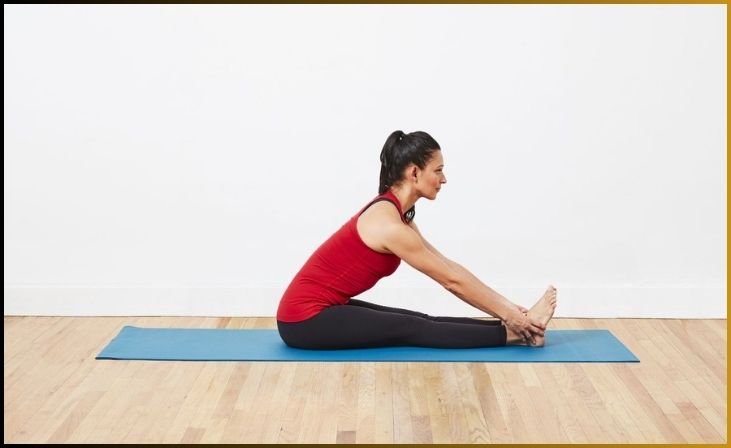Effective Lower Back Stretches to Relieve Pain
Lower back pain is a common and often debilitating issue that affects millions of people around the world. Whether it’s due to a sedentary lifestyle, poor posture, heavy lifting, or even stress, the discomfort and limitations caused by lower back pain can be a daily struggle. If you’re reading this, chances are you’re one of those individuals seeking relief from the persistent ache or occasional twinges in your lower back.
The good news is that you’re not alone, and there’s hope for a pain-free future. In this comprehensive guide, we’ll explore the world of lower back stretches—simple yet highly effective exercises that can significantly alleviate and prevent lower back pain. These stretches can be performed in the comfort of your own home, and they require no special equipment. Whether you’re a seasoned athlete looking to enhance your performance or someone who simply wants to go about their daily activities without the burden of pain, this guide is tailored to help you on your journey to a healthier, more comfortable life.
Join us as we delve into the science, benefits, and step-by-step instructions for various lower back stretches that can provide the relief you’ve been longing for. Say farewell to stiffness and pain in your lower back and hello to greater mobility and comfort.
Understanding Lower Back Pain
Lower back pain is a prevalent and often perplexing condition that can affect individuals of all ages and lifestyles. To effectively address and relieve this discomfort, it’s essential to understand the underlying causes and contributing factors.
Common Causes of Lower Back Pain
Lower back pain can occur from a number of sources, and identifying the specific cause is important for effective treatment. Some of the most common causes include:
- Muscle Strain: The muscles and ligaments in the lower back can be strained by overexertion, heavy lifting, or sudden movements, causing pain and discomfort.
- Poor Posture: Maintaining improper posture, especially while sitting or standing for extended periods, can place excessive stress on the lower back muscles and result in chronic pain.
- Herniated Discs: When the soft, gel-like discs between the vertebrae rupture or bulge, they can compress nearby nerves, causing sharp, shooting pain in the lower back.
- Degenerative Conditions: Conditions like osteoarthritis or degenerative disc disease can lead to the gradual deterioration of the spine’s components, contributing to persistent lower back pain.
- Spinal Abnormalities: Structural issues such as scoliosis, spinal stenosis, or sacroiliac joint dysfunction can cause chronic lower back pain due to misalignment or nerve compression.
- Stress and Mental Health: Emotional stress and anxiety can manifest physically, often leading to muscle tension and lower back pain.
- Inactivity: A sedentary lifestyle weakens the core and back muscles, making them more susceptible to strain and discomfort.
Also read: Best Free Weight Exercises for a Powerful Physique
The Role of Muscle Tightness
Muscle tightness in the lower back can be both a cause and a consequence of pain. When the muscles surrounding the lower spine become tight or tense, they can pull on the spine, leading to misalignment and pain. Additionally, muscle tightness can restrict blood flow to the area, impeding the body’s natural healing processes.
Over time, this tension can become chronic, intensifying lower back pain and making it more challenging to find relief. Stretching plays a crucial role in addressing this tightness, as it helps relax the muscles, improve flexibility, and reduce the likelihood of future pain.
Benefits of Regular Stretching
Stretching is often underestimated in its ability to improve overall well-being and reduce the discomfort associated with lower back pain.
1. Improved Flexibility and Range of Motion
One of the most noticeable benefits of regular stretching is increased flexibility. As you stretch your muscles regularly, they become more pliable and adaptable. This enhanced flexibility not only allows you to move more freely but also reduces the risk of muscle and ligament strains, which can contribute to lower back pain. With a greater range of motion, you’ll find it easier to perform everyday tasks and engage in physical activities without discomfort.
2. Reduced Muscle Tension and Soreness
Muscle tension and soreness in the lower back are common culprits of pain. Stretching helps alleviate this tension by promoting blood circulation to the muscles, delivering essential nutrients and oxygen. Because of this boost in circulation, waste products like lactic acid, which can cause muscle soreness, are flushed out of the body. As a result, regular stretching can lead to a significant reduction in muscle tightness and discomfort.
3. Enhanced Circulation and Healing
Stretching not only promotes better circulation within the muscles but also throughout the entire body. Improved circulation ensures that the injured or inflamed tissues in your lower back receive the necessary nutrients and oxygen for faster healing. Additionally, it helps flush out toxins, reducing inflammation and pain in the affected area. Enhanced blood flow also contributes to better overall cardiovascular health.
4. Stress Reduction
Stress can exacerbate lower back pain by causing muscle tension and promoting poor posture. Regular stretching routines provide an opportunity to relax and de-stress. Incorporating deep breathing techniques during stretching can further enhance stress reduction, promoting a sense of calm and well-being.
5. Posture Improvement
Stretching exercises that target the muscles responsible for maintaining proper posture, such as the lower back and core muscles, can help correct postural issues. By strengthening and lengthening these muscles, you’ll find it easier to maintain a natural and healthy spinal alignment, reducing the risk of lower back pain associated with poor posture.
Also read: Delicious Ideas for Low-Carb Diet
Lower Back Stretches to Relieve Pain
Now that we understand the importance of addressing lower back pain and the benefits of regular stretching, let’s delve into specific lower back stretches that can provide much-needed relief. These stretches are designed to target the muscles and areas in and around the lower back, promoting relaxation, flexibility, and pain reduction. Remember to perform these stretches mindfully, without forcing or causing discomfort.
Child’s Pose

Instructions:
- Start on your hands and knees, with your wrists aligned under your shoulders and your knees under your hips.
- Slowly sit back on your heels while reaching your arms forward.
- Lower your forehead to the floor, or as far as comfortable.
- Hold this posture for 30 to 60 seconds while inhaling deeply.
Benefits for pain relief:
- Stretches the lower back and promotes relaxation.
Also read: The Ultimate Guide to Stretches for Runners
Cat-Cow Stretch

Instructions:
- Start by getting down on your knees.
- Inhale, arch your back, and lift your head and tailbone (Cow Pose).
- Relax your shoulders and round your back into Cat Pose.
- Repeat this motion for 1-2 minutes
Benefits for pain relief:
- Promotes flexibility in the spine and stretches the lower back.
Seated Forward Bend

Instructions:
- Keep your legs extended in front of you while seated.
- Hinge at your hips and reach for your toes.
- According to your level of flexibility, hold onto your shins, ankles, or feet.
- For 30 to 60 seconds, hold the stretch.
Benefits for pain relief:
- Stretches the lower back and hamstrings.
Cobra Stretch

Instructions:
- Your palms should be close to your shoulders as you are lying on your stomach.
- Slowly lift your chest off the floor, keeping your hips grounded.
- Hold for 15 to 30 seconds, extending the time as you advance.
Benefits for pain relief:
- Strengthens and stretches the lower back.
Knee-to-Chest Stretch

Instructions:
- Lie on your back with your knees bent and your feet flat on the floor.
- One knee should be brought up to your chest and held with both hands.
- After holding for 15 to 30 seconds, move to the other knee.
Benefits for pain relief:
- Stretches the glutes and releases lower back tension.
Pelvic Tilts

Instructions:
- Lie on your back with your knees bent and your feet flat on the floor.
- You should tighten your abdominal muscles and press your lower back into the floor.
- Hold for 5-10 seconds, then release.
- Repeat 10-15 times.
Benefits for pain relief:
- Strengthens the core and promotes stability in the lower back.
Bridge Pose

Instructions:
- Lay on your back with your feet hip-width apart, knees bent, and feet flat on the ground.
- To make a straight line from your shoulders to your knees, raise your hips off the ground.
- Hold for 20-30 seconds, gradually extending the duration with practice.
Benefits for pain relief:
- Strengthens the lower back, glutes, and hamstrings.
Cat-Camel Stretch

Instructions:
- Begin on your hands and knees.
- Arch your back (Cat Pose) while inhaling.
- Round your back (Camel Pose) while exhaling.
- Repeat for 1-2 minutes.
Benefits for pain relief:
- Enhances flexibility and mobility in the lower back.
Also read: Bliss Belly Fat Trimming Tea’s
Tips for Lower Back Pain Relief
While lower back stretches play a crucial role in pain relief, adopting a holistic approach to managing lower back pain is essential for long-term relief and prevention. In this section, we’ll explore additional tips and strategies that complement your stretching routine and contribute to a healthier, pain-free lower back.
1. Ergonomic Workspace Setup
Many of us spend a significant portion of our day sitting at a desk or working on a computer. An ergonomic workspace setup can significantly reduce the strain on your lower back:
- Use an adjustable chair with lumbar support to maintain the natural curve of your lower spine.
- Position your computer screen at eye level to avoid tilting your head and straining your neck and back.
- Take regular breaks to stand, stretch, and walk around.
2. Proper Lifting Techniques
Improper lifting can lead to acute lower back injuries. Whether you’re lifting heavy objects at work or simply picking up items at home, follow these guidelines:
- Bend your knees and hips, not your back, when lifting.
- Maintain the item close to your body.
- Instead of lifting with your back muscles, use your leg muscles.
- Avoid twisting while lifting.
3. Maintain a Healthy Weight
Excess weight, especially around the midsection, can strain the lower back. Achieving and maintaining a healthy weight through a balanced diet and regular exercise can reduce the stress on your spine and alleviate lower back pain.
4. Stay Active
Regular physical activity strengthens the muscles that support the lower back and can reduce the risk of pain. Incorporate activities like walking, swimming, or low-impact exercises into your routine to keep your back muscles strong and flexible.
5. Good Posture Habits
Maintaining good posture is crucial for preventing and relieving lower back pain. Practise the following:
- When sitting, keep your feet flat on the floor, and your knees and hips at 90-degree angles.
- Use a chair with proper lumbar support.
- Stand with your weight evenly distributed between both feet.
- Avoid slouching and hunching your shoulders.
Conclusion
Incorporating lower back stretches into your daily routine, along with these complementary strategies, can pave the way for a life free from the burden of lower back pain. By understanding the causes, benefits of stretching, and adopting healthy habits, you empower yourself to take control of your well-being. Remember that consistency and patience are key on your journey to a healthier, pain-free lower back. Embrace these tips, stay committed to your stretching routine, and relish the freedom of a life with reduced lower back pain.
FAQ
It’s generally recommended to perform lower back stretches at least once a day, especially if you’re experiencing pain. However, you can increase the frequency to 2-3 times a day if needed, but avoid overstretching to prevent injury.
If you have a pre-existing condition or have recently had back surgery, it’s crucial to consult a healthcare professional or physical therapist before attempting these stretches.
The duration of each stretch can vary, but a general guideline is to hold each stretch for 15-30 seconds initially. As you become more flexible, you can gradually increase the hold time to 1-2 minutes for deeper relaxation and pain relief.




